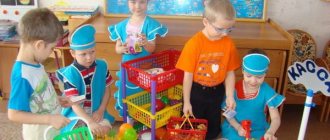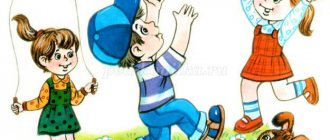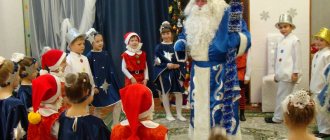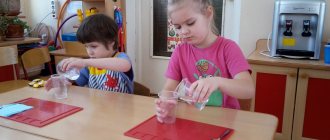“Synopsis of GCD for the senior group “Insects in autumn”
MDOU "Kindergarten No. 25 "Beacon" Frunzensky district of the city of Saratov Summary of direct educational activities on the topic: "Insects in autumn" (using ICT) in senior group No. 1
Prepared by: teacher of the highest category N.A. Gorbacheva Program “Childhood” Senior group “Insects in autumn” Goal: to promote the accumulation of specific ideas about insects. Objectives: To clarify children’s understanding of insects, to be able to isolate their main features (segmented body structure, six legs, the presence of antennae, chitinous cover), to know where the insects have disappeared and where they find refuge. Introduce children to the development cycles of insects. Establish cause-and-effect relationships, the ability to use models in cognitive activity. Develop children’s cognitive activity and observation skills. Develop the ability to compare, highlight common and distinctive features. Foster a caring attitude towards nature and all living things. Working at the computer: Learn to navigate the conditions of a task, plan the course of a solution, provide and evaluate possible options. Orientate yourself in time by arranging events in a certain sequence. Strengthen mouse skills: moving the mouse cursor over table cells, “clicking” on an item, “drag” an item into place
Types of activities: gaming, educational-research, musical Forms of organization: frontal Form of implementation: problem situation Equipment: Multimedia installation. Workbook for children 5 – 6 years old “Welcome to ecology!” part 1. Pencils for each child. Photo illustrations of various insects. Mnemonic table “Insects”. Computer game “What first, what then” (author’s development): Scheme “The development cycle of a butterfly”. Scheme "Ladybug development cycle." Diagram “Dragonfly development cycle.” Mnemonic table based on the poem “Giant” by N. Dymova (compiled together with children). Recording of the song “Autumn” and CD player. Butterflies on magnets. Note: after viewing the required number of slides, the curtain on the multimedia installation closes and the image disappears. The total time for working with the slides is approximately 7 minutes (corresponds to SanPiN). GCD move. 1 part. Children enter the developmental education classroom with the song “Autumn has come.” Talk with children about what time of year it is. Please name the signs of autumn. (Children's answers) I ask the children about insects - what do they do in the fall? (Children's answers) Part 2. Guys, Dunno from our ecology workbook doesn’t know. Let's help him and show him where insects hide for the winter. The children sit at the tables. Work in the workbooks “Welcome to Ecology” for children 5-6 years old (senior group), part 1, page No. 8. Assignment: “Draw a path from each insect to its shelter.” Children complete the task, then tell them that the bark beetle hibernates under the bark of trees for the winter, ants hide in an anthill, ladybugs hide in old stumps, and flies hibernate under fallen leaves. Part 3. Wherever we go - in the garden, in the meadow, in the forest - we are surrounded by insects - our little neighbors. But are they so invisible? Take, for example, an ant - one of them is so small, tiny, you won’t even notice it right away! But in a large anthill there are so many of them that if you measure them in buckets, you will get several buckets!!! (slide No. 1) How many of them are there, like you
schoolfiles.net
We walked around the garden, observing nature
16.10.2017
Quiet, warm, gentle autumn carries withered leaves everywhere, painting them lemon and orange. She sprinkles them on sidewalks, lawns, alleys, not sparing at all...
Autumn is one of the favorable times of the year for observing changes in nature, and you can do them while walking. After all, a walk is always an interesting event for children. This is a source of new experiences and impressions. Autumn bad weather, of course, reduces the time spent outdoors, but cloudy weather is not a reason to stay at home. All you have to do is collect your toys, choose a suitable route, call your friends and you can go for a walk.
On one of the fine October days, the children of the “Kapelka” junior preschool group, kindergarten No. 45, and I took a fascinating, entertaining and educational walk on the topic “We walked around the kindergarten...”, and set off on a fun little train. Moving forward along the paths of the site, the kids said in unison: “In the morning the sky was gloomy, and everything seemed gloomy. Autumn loves to cry and rain on the ground. He loves to rustle leaves and pick them from trees.”
How many exciting, useful, interesting things the kids learned and saw while traveling around the territory of the kindergarten, they gained new knowledge about their surroundings, which caused joyful cries, delight, and surprise among the children. The children clearly saw autumn changes in nature, for example, leaf fall. How interesting it is to watch leaf fall with your children, paying attention to which trees fall off leaves first and which ones last longer, to admire the beauty of leaf fall, saying the words: “The leaves are falling, falling leaves in our garden!” Did you find out why autumn is called “golden”? But why, it turns out, trees put on their autumn attire - answered Semyon Ulas and Masha Ponomareva. Indeed, her outfit is very beautiful and colorful. The leaves of the birch are yellow, and those of the maple are yellow, red, and crimson. At this time of year, the trees celebrate their last ball.
Which tree is the most beautiful? - I asked the children. “Birch tree!”, the kids said in unison, stopped near it, admired its beauty, hugged it tenderly and touched its trunk with their heads. The mountain ash seemed to attract the kids to its branches with red, openwork leaves. How you want to stand under them, the leaves that have survived the wind and rain. And other shrubs attracted the children’s attention with their bright, colorful leaves, making it simply impossible not to stop near them. The most beautiful autumn time! With the arrival of autumn, plant leaves change color. The trees do not all turn yellow at once, they change color one by one, preparing for the winter cold.
Despite the fact that the walk was held on the territory of a kindergarten, you can always see a lot of interesting things here. You just need to help children notice and see all the beauty of the surrounding nature. And here are the flower beds. All summer, the kids and I admired the colors of the flowering plants on them. Autumn has come, the flowers have wilted, but the hardiest flowers, which are not afraid of the cold and rain, still delight and enchant us, adults and children, with their attractive, tempting beauty!
Children walk along the paths, wearing rubber boots and carrying umbrellas in their hands like flowers. Our kids are not afraid of drizzling rain; they want it to rain harder. Standing under an umbrella, they cheerfully shout: “Go, go, rain, let’s cook you borscht!” Porridge for you, and borscht for us, so that it rains harder!” You can’t imagine, puddles are so interesting! This is one of the most attractive places for children! They love to walk through puddles, throw pebbles into them, and measure the depth. “Look how I can do it! And me!” Dima Pesterev, Sasha Kondratyeva and Artyom Prokhorov rejoiced, splashing their boots on the puddle.
Bird watching in autumn is a great pleasure for inquisitive kids. Traveling on a cheerful train along the autumn paths, we did not forget to take with us a treat for the birds: some seeds and a crust of bread, in case we see birds. Indeed, it was as if a flock of pigeons were waiting for us to visit. Having crumbled the bread and poured in the seeds, quietly, as if holding their breath so as not to frighten the birds, the children watched with interest as the birds helped themselves and pecked at the food.
Such a fascinating, memorable event was a walk for our kids. Observations of living and inanimate nature, natural seasonal changes develop children's memory, attention, and cultivate a caring and thoughtful attitude towards the world around them. A child should not mindlessly look at nature, but see and understand natural phenomena and the connection between them. By examining, thinking, comparing, contrasting, the child simultaneously develops speech and thinking. “If you want to teach a child to think logically, take him into nature,” advised the famous Russian teacher and writer K. D. Ushinsky.
Communication with nature instills in a child a sense of beauty. If adults teach a child to admire the bright colors of the sky, the beautiful colors and shapes of leaves, and listen to beautiful sounds in nature, the child will develop a sense of beauty, he will rejoice in beauty and depth, learning about the world around him. Communication with living nature gives a child more vivid ideas than the most beautiful picture book. And how right the famous French philosopher and writer, Fr.
The material was prepared by Tamara Ivanovna Savchuk, teacher of the private educational institution “TsRR “Solikamskbumprom” kindergarten No. 45
Return to News section





